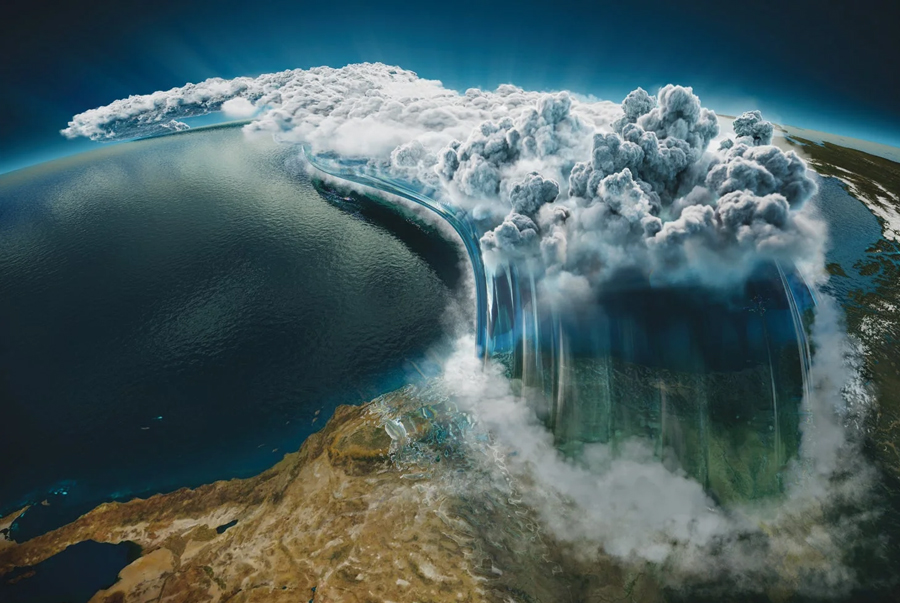Hi readers just start thinking about the world largest rivers and the names immediately coming to the mind may comprise Yangtze of China, Brahmaputra of India, Indus of Pakistan, Amazon of South America, Nile of Egypt and Mississippi of North America but, it will be surprising for many of you that some of the world’s largest freshwater rivers are in the sky called “atmospheric rivers” or rivers are in the sky. Amazing isn’t it? These are long narrow bands of moisture in the atmosphere that extend from tropics of the Earth (regions surrounding the Equator) to higher altitudes (areas between 60 degrees N/S to poles i.e., 90-degree N/S) which can transport 15 times more water than that of the Mississippi.
Introduction
In the language of fluid mechanics, a sky river is an overview of various meteorological systems including tropical cyclones, extratropical frontal cyclones, cutoff lines and others. All these systems have one common feature of having a communicating surface between two air masses with contrasting and/or antagonistic velocities, temperatures, humidity, and pressures. Influenced by the large gradients of these forces, concentrated water vapors flows along the paths on the communication surfaces like rivers network flow on the earth surface, characterized by cloud and precipitation processes along the paths. In simple language
Atmospheric rivers are like highways of water vapors between the tropics and poles and are located in the first one to three kilometers of the atmosphere. They are responsible for about 90 % of water vapors moving from north to south of the planet, despite covering only 10% of the globe.
When atmospheric rivers crash into mountain ranges or interact with cold fronts, they rain out this water with potentially disastrous impacts. Mountains and fronts lift the water vapors up in the atmosphere where it cools and condenses into giant, liquid-forming bands of clouds. Intense thunderstorms can also form within atmospheric rivers.
In1960s, meteorologists coined the phrase “Pineapple Express” to describe storm tracks that originated near Hawaii and carried warm water vapor to the coast of North America. In dry conditions, atmospheric rivers can replenish water supplies and reduce dangerous wildfires. In wet conditions on the other hand, they can cause devastating floods and debris flows, causing disastrous damage to local economies.
These Atmosphere rivers are roaming through the sky for millions of years, transporting water vapor from the equator toward the poles. In 1990s atmospheric scientists found that over 90 % of the world’s moisture from the tropics and subtropics was transported to higher latitudes by similar systems, which they named “atmospheric rivers”.
Atmospheric rivers occur globally and affect West coasts of the world’s major regions including Portugal, Western Europe, Chile, and South Africa. The so-called “Pineapple express” is an atmospheric river forms near Hawaii (where pineapples are grown) that bring moisture from Hawaii to West coast of USA. The Pineapple Express storm that hit Southern California in 2005 was supposed to be the largest after the storms that hit during the 1997–98 El Niño that cause most of the flooding and damage in Western USA. Nevertheless, there is yet another catastrophic flooding and landslide caused by atmospheric rivers in California’s history. The intensity of the current Pineapple Express storm (December, 2022) that landed after one of the driest years on record was of a level of 4-5 atmospheric rivers, and comes along with several other storms, claimed several lives, triggered evacuations and water rescues up and down the Golden State (San Francisco, California, Los Angeles and San Diego) putting state of California under emergency and ruined 2022’s Christmas. The current storm going in the Western USA is of the same kind and is of century’s worst storm as it is being claimed.
The impact and effects of Atmospheric rivers (ARs)
Imagine, that half of the California’s water supply comes from ARs often in the form of powerful downpours that can hit in series and cause floods. In the absence of AR, California gradually proceed towards droughts and get out of it only when downpour occurs. Many in the Western countries who are tired of seasonal fire welcome these downpours forgetting that the atmospheric rivers can trigger extreme flooding and debris flows especially when such downpours comes in series, occur over a prolonged period of time or are very intense., they inflict heavy loses to lives and properties.
On February 27, 2019, an atmospheric river pushed a cloud of water vapor through the sky from the tropical North Pacific Ocean to the coast of Northern California and was 350 miles wide and 1,600 miles long. The storm dumped over 21 inches of rain in Sonoma county (North of San Francisco Bay) only. The Russian River peaked at 45.4 feet (13.4 feet above flood stage) caused damages of over hundreds of millions in Sonoma county alone.
Researchers have known for some time that flooding due to atmospheric rivers could cost a lot of money, but no serious effort has been made to quantify these damages. However, a study made at Scripps Institute of Oceanography’s Center for Western Weather and Water Extremes, using 40 years of flood insurance records and 20 years of National Weather Service damage estimates revealed that flood damages are of the tune of an average of $1.1 billion per annum in the Western U.S.A., only where more than 80% of all flood damages were associated with atmospheric rivers. In Northern California, these systems caused over 99% of damages. The data also showed that in an average year, about 40 atmospheric rivers made landfall along the Pacific coast between Baja California and British Columbia. Most of these events were benign and replenished the region’s water supply. But according to recently developed atmospheric rivers classification that ranks the storms from 1 to 5, are similar to the systems that categorize hurricanes and tornadoes hence, there is a clear link between these categories and observed damages. The most significant finding of the study was an exponential relationship between the intensity of atmospheric rivers and the flood damages they caused. Each increase in the scale from 1 to 5 was associated with a 10-fold increase in damages.
Atmospheric River category 1 (AR1) and 2 (AR2) storms caused damages under $1 million. AR4 and AR5 storms caused median damages in the range of 10s and 100s of millions of dollars respectively. The most damaging AR4s and AR5s generated impacts of over $1 billion per storm. These billion-dollar storms occurred every three to four years
The role of climate change?
A study made on the future atmospheric rivers as big as the one that hit Sydney: Australia on March 2021 (when thousands of people in parts of Sydney’s Northwest were ordered to evacuate their houses in the middle of the night as Australia’s east coast was hit by record rainfall and widespread flooding) using the latest climate models CMI6 revealed that earth is currently on track for 2.7o warming by the end of the century which means the chances of weather similar to March 2021 floods will increase by 80%, thereby triggering more extreme rainfall and flooding in Sydney. The overall change in climate will increase the occurrence of atmospheric rivers over the planet.
However, some researchers have argued that natural variability has helped produce a pattern of warming in recent years that leads to lower global temperatures than would otherwise have occurred (please read my blog on “Climate is changing alarmingly? OMG but how it is changing?” posted on June 30th, 2022), making it challenging to use observed warming for future projections.
Therefore, more research is needed to determine just how often we can expect these damaging events to happen, including the one in Southeast Queensland. There is still time to change the outcome if we urgently reduce emissions to stop global warming beyond 1.5℃ during this century. Every little bit we do to limit carbon emissions might mean one less flood and one less person who has to rebuild.
How to reduce atmospheric rivers mediated flooding and destruction?
By giving priority to improving atmospheric forecasting systems for adapting to a changing climate and developing better understanding of atmospheric river’s intensity, duration, and landfall locations. This can provide valuable information to the residents and emergency responders who can be saved in advance from damages inflicted to lives and property of the residents hit by the storm.
Construction in high-risk areas should be stopped forthwith while helping the people to move to safer locations after major disasters, rather than rebuilding their places (this is more important in Pakistani case).
Finally, it is important to reduce global greenhouse gas emissions. These storms will keep coming, and they’re getting stronger and stronger hence, stabilizing the global climate system is the only long-term way to minimize economic damages and risk to vulnerable communities.
That’s all-dear readers. Next blog will describe atmospheric rivers in the Middle East and North African (MENA) region and the impact they are making there. Atmospheric rivers in the Himalayan region may also be included. So, keep your figures crossed and I will see you next week.
Till then, take care.
Bye





